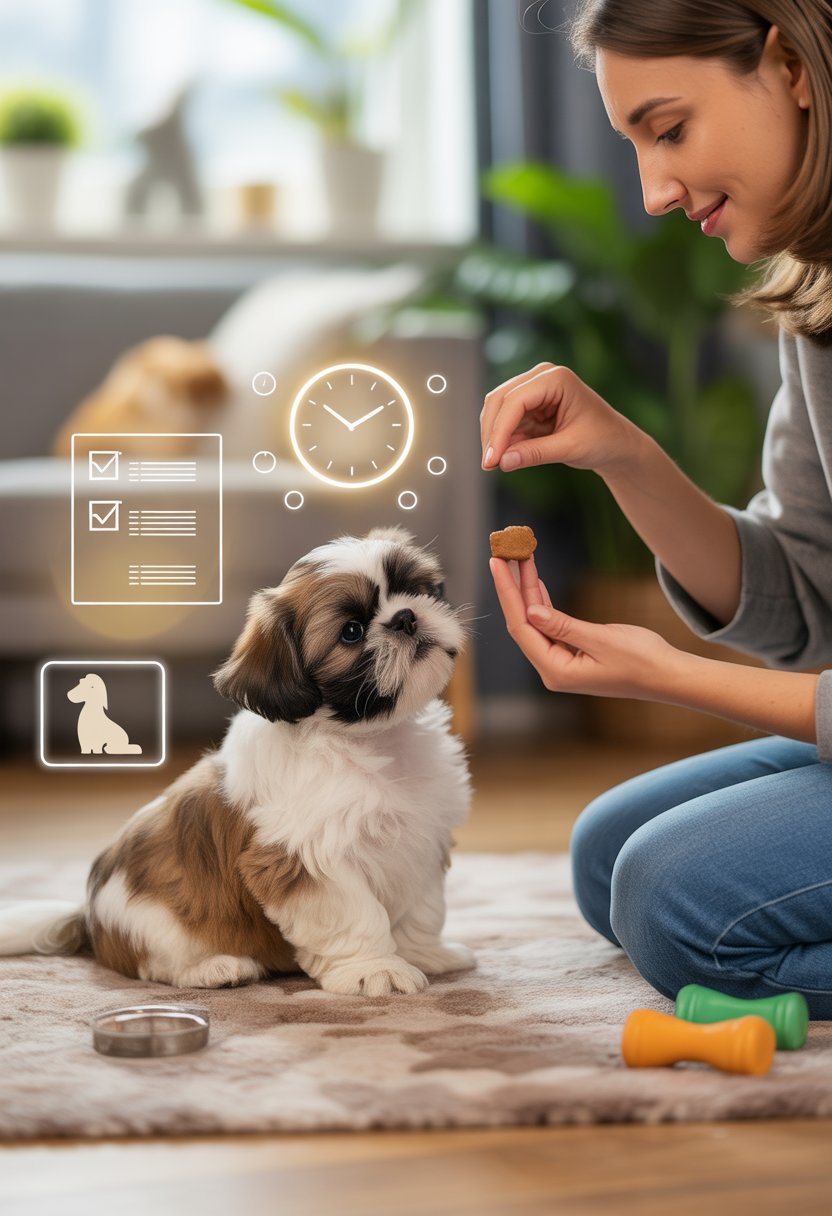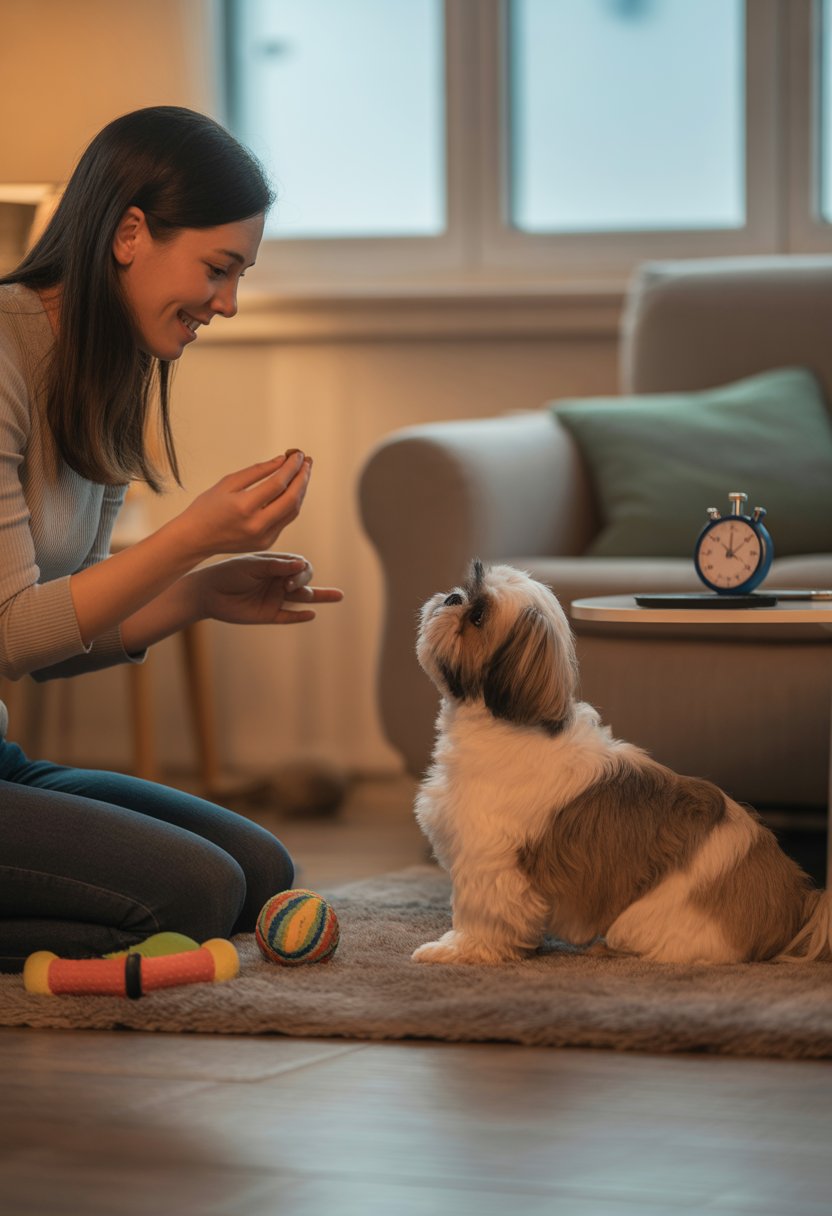Training a Shih Tzu can really test your patience, especially when their stubborn streak kicks in. You want your pup to listen, but you also want the whole thing to feel positive and not stressful for either of you.
The key? Find simple ways to stay calm and consistent so your dog actually enjoys the training as much as you do.
With the right mindset and a few practical hacks, each session can feel smoother and more rewarding. You’ll figure out how to set small goals, keep things fun, and manage your own frustration so progress feels steady—not overwhelming.
Set small, achievable training goals to keep frustration low

When you work with your Shih Tzu, it helps to focus on one simple skill at a time. Trying to teach too much at once just overwhelms both of you.
Small steps make progress easier to spot. Start with easy commands like “sit” or “stay” for a few seconds.
When your dog gets it right, reward them right away. This keeps training positive and builds confidence for both of you.
Break bigger goals into smaller ones. If you want a longer “stay,” start with a second or two, then slowly add time.
Your dog learns without feeling too much pressure. You’ll also feel less frustrated as you notice steady progress.
Meeting small goals gives you those quick wins that keep you motivated. Remember, your Shih Tzu doesn’t need to master everything in one go.
Short, focused practice sessions work better than long, drawn-out ones.
Use high-value treats your Shih Tzu loves as rewards
When you train your Shih Tzu, the treats you use matter—a lot. Regular kibble might not cut it, but a high-value treat? That’ll get their attention.
Try small pieces of soft treats, tiny bits of chicken, or special store-bought options. Pick something your Shih Tzu doesn’t get all the time so it feels like a real reward.
Keep treats tiny so your dog doesn’t fill up too fast. That way, you can reward often without overfeeding.
It helps to save one special treat just for training. Your Shih Tzu will start to think, “Listening to you means I get that awesome snack,” and you’ll see them tune in.
High-value treats don’t just keep training fun. They actually help your pup build patience, since they learn to wait for the reward after following your cue.
Keep training sessions short—5 to 10 minutes max
Your Shih Tzu’s attention span isn’t super long, so shorter sessions work best. Aim for 5 to 10 minutes at a time—long lessons just lead to boredom.
Short sessions keep your dog engaged and more willing to learn. You’ll also find it easier to stay patient when you’re not slogging through a marathon session.
Try a few short sessions throughout the day instead of one long one. That gives your Shih Tzu more chances to practice without feeling overwhelmed.
End each session on a positive note, like a simple trick or a successful command. Your dog will start to link training with success and fun.
Stay consistent with commands and routines every day
Your Shih Tzu learns best when you use the same words and routines every time. If you switch up the command or skip steps, your dog just gets confused.
Stick with the same cues so your dog knows exactly what you want. Daily routines make it easier, too.
Feeding, walking, and practice at the same times each day give your Shih Tzu a schedule they can count on. That regular pattern helps your dog feel calm and focused.
Keep commands short and simple. Use the same tone of voice so your dog recognizes the cue right away.
Everyone in your home should use the same words. Mixed messages just slow things down.
Repetition builds habits. The more often you practice the same way, the faster your Shih Tzu will remember.
Even five minutes a day can make a big difference. When you stay consistent, your dog learns to trust you, and that trust makes teaching new skills way easier.
Celebrate every tiny success with praise and pets

When your Shih Tzu follows a command—even if it’s just sitting for a second—make sure you notice. A quick “good job” or a gentle pat can mean a lot.
Don’t wait for big milestones. Small steps, like staying calm when the doorbell rings or walking nicely for a few feet, deserve attention too.
Use simple rewards like treats, belly rubs, or a cheerful tone. Your Shih Tzu will start to connect good behavior with good things.
Over time, training feels more like fun than work. Celebrating little wins helps you stay patient, too.
Progress can feel slow, but noticing the small stuff reminds you your pup’s learning. It keeps both of you encouraged to keep going.
Incorporate play breaks to keep your pup engaged

Training can get boring for your Shih Tzu if you don’t mix it up. Short play breaks help your pup reset and come back ready to focus.
A few minutes of tug or fetch lets your dog burn off energy. After that, it’s easier for them to pay attention.
Play also gives you both a chance to have fun together. That positive interaction builds trust and makes training feel less like a chore.
Keep the breaks short—just a couple of minutes. If play goes on too long, your Shih Tzu might lose focus and not want to get back to work.
You can use toys, gentle chase games, or even belly rubs as quick rewards. Pick something your pup enjoys but can calm down from quickly.
By mixing short lessons with playful moments, you make training more enjoyable. Your Shih Tzu will stay engaged and actually look forward to each session.
Practice deep breaths or a quick walk if you feel frustrated

When your Shih Tzu ignores you or gets distracted, it’s easy to get frustrated. Instead of reacting, just pause and take a few slow breaths.
That can calm your body and help you reset before you keep going. If breathing isn’t enough, step away for a short walk.
Even a few minutes of movement can help you shake off tension and clear your head. You’ll come back to your dog with more patience.
Your Shih Tzu picks up on your mood, so staying calm makes training smoother. A quick break keeps frustration from building up and spoiling the experience for both of you.
Think of these pauses as part of the process. By giving yourself space to breathe or walk, you set a better example of calm behavior for your dog.
Understanding Shih Tzu Temperament
Shih Tzus are affectionate and loyal, but yeah, they’ve got a stubborn side. Their personality mixes charm, independence, and a need for gentle guidance.
Why Patience Matters in Training
You’ll notice your Shih Tzu learns best when you stay calm and consistent. If you rush or get frustrated, they might just ignore you.
Patience helps you build trust, and trust is the foundation for teaching anything new. This breed responds well to positive reinforcement—treats, praise, or playtime.
Harsh corrections usually backfire and make them dig in their heels. If you keep your tone upbeat and rewards clear, you’ll see steady progress.
Short, simple sessions work best. Shih Tzus have short attention spans, so a 5–10 minute session beats a long drill every time.
Common Challenges with Shih Tzus
Shih Tzus can be a little headstrong. They might bark for attention, resist potty training, or pull on the leash.
These aren’t signs of disobedience—they’re just part of their independent streak.
Typical challenges you might face include:
- Potty training accidents indoors
- Barking at strangers or noises
- Ignoring commands when distracted
- Refusing to walk at your pace
You can manage these with consistency and clear boundaries. For example, taking your Shih Tzu outside on a schedule helps with house training.
Rewarding quiet behavior can cut down on barking. It takes time, but once your Shih Tzu knows what you expect, they usually settle into routines.
With patience, you’ll see fewer stubborn moments and more cooperation.
Creating a Positive Training Environment
Your Shih Tzu learns best when training feels safe, clear, and rewarding. Consistency and positive reinforcement help your dog understand what you want and make things less stressful for both of you.
Establishing Routines
Shih Tzus do best when they know what’s coming each day. A set schedule for meals, potty breaks, and short training sessions helps your dog feel secure.
Keep training sessions short—just 5 to 10 minutes. That way, your dog’s attention doesn’t wander.
Try spreading training throughout the day instead of cramming everything into one block.
Stick with the same words for commands every time. For example, always say “sit” and avoid switching it up with “sit down.”
Clear, repeated cues make things easier for your dog to understand.
Start out training in a quiet spot. Distractions like other pets or loud noises just make things harder.
Once your Shih Tzu gets the hang of a skill, slowly add more distractions. That’s how they’ll build real confidence.
Using Rewards Effectively
Rewards can really motivate your Shih Tzu to repeat good behavior. Small, soft treats are usually best since your dog can eat them fast and stay focused.
Praise, petting, or even a favorite toy can work too, depending on what your dog actually likes. Every dog’s a little different, so don’t be afraid to experiment.
Timing is everything. Give the reward right after your dog does the right thing, or they might not make the connection.
If you wait too long, your pup might get confused about what they’re being rewarded for. That’s just frustrating for everyone.
Mix things up now and then to keep training fun. For example:
- Treats: tiny pieces of chicken or dog-safe snacks
- Verbal praise: a cheerful “good job!”
- Play: tossing a toy for a quick fetch
Don’t hand out rewards if your dog hasn’t followed the command. That just waters down the meaning, and honestly, it makes your Shih Tzu less likely to listen next time.



